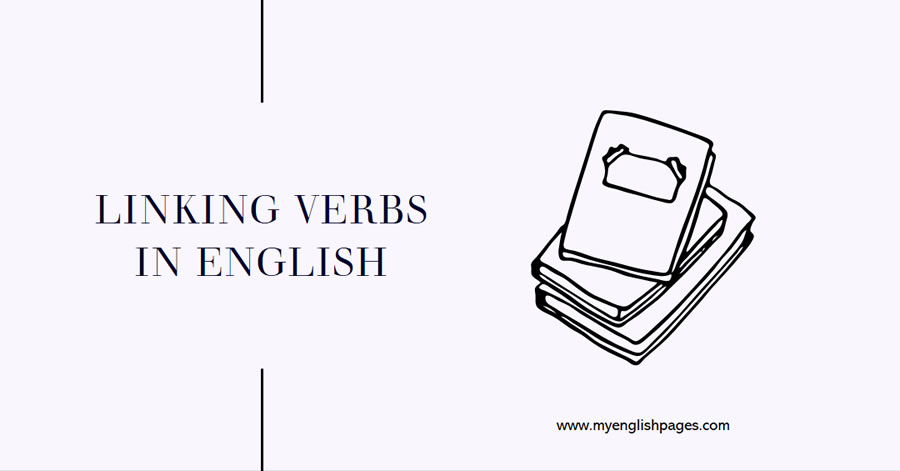Table of Contents
Introduction
Linking verbs in English are the silent connectors in our sentences, joining subjects with their complements. This article breaks down linking verbs — what they are and how to use them, and provides examples and a handy list.
Let’s get started with a definition of linking verbs!
What are linking verbs In English?
Linking verbs in English are verbs that connect the subject of a sentence to a subject complement, which can be a noun, pronoun, or adjective. Unlike verbs that express action, linking verbs describe a state of being or a condition. The complement that comes after linking verbs contains additional information describing and identifying the subject.
Linking verbs are also referred to as copulas or copular verbs.
Examples:
- Larry looks happy. (looks is a linking verb; happy is a complement that describes and identifies Larry, the subject)
- The play was good. (was is a linking verb; good is a complement that describes and identifies the play, the subject
Here are more examples of linking verbs:
- She is a talented musician.
- I am excited about the upcoming event.
- They are diligent students.
- He was the team captain.
- We were ecstatic about the news.
- The caterpillar will become a butterfly.
- The task seems challenging.
- She feels tired after the long journey.
- The garden looks stunning in the spring.
- The music sounds soothing.
In these examples, the linking verbs (is, am, are, was, were, become, seem, feel, look, sound) connect the subject of the sentence to additional information that describes or identifies it.

How To Use Linking Verbs In English?
Typically, sentences consist of a subject and a predicate. In sentences where the verb expresses an action, such as “work” or “play,” the predicate typically provides more information about the action carried out by the subject. Take, for instance, the sentence:
- “Jane plays tennis every Sunday.”
Here, “Jane” is the subject—the one performing the action—and “plays tennis every Sunday” forms the predicate. The verb “plays,” in its simple present tense, is an action verb. The adverbial phrase “every Sunday” is also part of the predicate, offering information about when the action occurs.
However, when dealing with linking verbs, a distinct pattern emerges. Linking verbs come with special predicates known as subject complements, which do not describe the action but instead characterize the subject. There are two primary types of subject complements for linking verbs:
- Predicate Nominative: This occurs when the words describing the subject take the form of nouns or noun phrases. For example:
- Jane is a doctor.
- The day became a celebration.
- Predicate Adjective: This occurs when the words describing the subject are adjectives or adjective phrases. Examples include:
- The flowers smell fragrant. The room feels cozy.
Linking Verbs Vs. Auxiliaries
Linking verbs and auxiliaries serve distinct purposes. Linking verbs, as previously discussed, connect the subject to a subject complement, describing the subject’s state or identity.
In contrast, auxiliaries, also known as helping verbs, collaborate with main verbs to convey various nuances of meaning, such as tense, mood, or voice.
Linking Verbs:
- Function: Linking verbs link the subject to a subject complement, emphasizing the subject’s state of being or condition.
- Examples: “is,” “am,” “are,” “was,” “were,” “become,” “seem,” “feel,” “look,” and “sound.”
- Use: Focus on describing the subject’s state or identity rather than specifying actions.
Auxiliaries:
- Function: Auxiliaries assist main verbs in expressing aspects like tense, modality, or voice.
- Examples: “is,” “have,” “will,” “can,” “must,” and “should.”
- Use: Work with main verbs to convey tense, mood, or voice in a sentence.
While both linking verbs and auxiliaries contribute to sentence structure, the key distinction lies in their roles. Linking verbs illuminate the subject’s characteristics, while auxiliaries enhance the precision and context of actions expressed by main verbs.
Here are examples illustrating the distinction between linking verbs and auxiliary verbs:
| Type of Verb | Example Sentence |
|---|---|
| Linking Verb | The cake smells delicious. |
| Auxiliary Verb | The chef is baking a cake. |
| Linking Verb | The movie seems interesting. |
| Auxiliary Verb | We are watching a movie. |
| Linking Verb | The flowers appear vibrant. |
| Auxiliary Verb | The gardener is planting new flowers. |
In each pair, the first sentence with a linking verb emphasizes a state of being or condition, while the second sentence with an auxiliary verb focuses on an action or ongoing activity.
Versatile Verbs: Linking and Action Roles
Several verbs in the English language have the unique ability to play dual roles as both linking and action verbs, depending on their usage within a sentence.
- Linking Role: In their linking capacity, these verbs connect the subject to a subject complement, providing additional information about the subject’s state or identity.
- Action Role: Alternatively, these verbs can also function as action verbs, indicating a specific activity or movement performed by the subject.
Examples:
- “Look”
- Linking Verb: He looks angry. (Describing his emotional state.)
- Action Verb: He looked at the man. (Indicating a specific action of looking at someone.)
- “Feel”
- Linking Verb: The blanket feels soft. (Describing the quality of the blanket.)
- Action Verb: She felt the fabric. (Expressing the physical action of touching.)
- “Smell”
- Linking Verb: The kitchen smells delicious. (Describing the aroma in the kitchen.)
- Action Verb: She smelled the flowers. (Indicating the action of inhaling the scent.)
- “Taste”
- Linking Verb: The soup tastes salty. (Describing the flavor of the soup.)
- Action Verb: He tasted the cake. (Referring to the action of tasting the cake.)
- “Appear”
- Linking Verb: The room appears spacious. (Describing the perceived size of the room.)
- Action Verb: She appeared at the door. (Referring to the action of making an entrance.)
A handy trick for distinguishing between the two is to examine the relationship between the subject and complement. If the verb is linking, it connects the subject to a subject complement, providing additional information about the subject’s state or identity. In contrast, action verbs involve the subject performing a specific action.
Let’s explore this concept through examples:
- “Look”
- Linking Verb: He looks angry. (“Angry” provides more information about the pronoun “he”, suggesting that he looks like an angry person.)
- Action Verb: He looked at the man. (He directed his gaze toward the man.)
- “Feel”
- Linking Verb: The blanket feels soft. (“Soft” provides more information about “the blanket” suggesting that it has the quality of being soft.)
- Action Verb: She felt the fabric. (She physically touched the fabric.)
Linking Verbs List
Here’s a table listing common linking verbs along with examples:
| Linking Verb | Example Sentences |
|---|---|
| am | I am a student. |
| is | She is a talented artist. |
| are | They are passionate about the environment. |
| was | He was the captain of the team. |
| were | We were excited about the news. |
| be | The flowers are beautiful. |
| being | The book is being read by many students. |
| been | She has been my friend for years. |
| become | The caterpillar will become a butterfly. |
| seem | The task seems challenging. |
| look | The sunset looks breathtaking. |
| feel | The fabric feels soft. |
| sound | The music sounds soothing. |
| taste | The soup tastes delicious. |
| smell | The flowers smell fragrant. |
| appear | The magician appeared mystifying. |
| grow | The plant grows rapidly in the sunlight. |
| remain | The mystery remains unsolved. |
| turn | The milk turns sour if left out too long. |
| prove | The evidence proved inconclusive. |
| stay | The weather will stay clear throughout the day. |
| look | The house looks spacious with the new furniture. |
| appear | The island appeared deserted from a distance. |
| feel | The fabric feels rough against the skin. |
| sound | His explanation sounds reasonable. |
| prove | The experiment proved successful. |
| get | His face got pale upon hearing the news. |
| grow | The children grow fast. |
This comprehensive table includes a variety of linking verbs, each accompanied by example sentences illustrating their use in forming subject complements.
Conclusion
In summary, linking verbs play a crucial role in sentence structure by connecting a subject to its complement, offering descriptions or additional details about the subject. Common examples of linking verbs include “be,” “look,” “seem,” and “taste,” among others.
It’s important to note the distinction between linking verbs and action verbs – while linking verbs emphasize the subject’s state or identity, the complement in a sentence with action verbs provides information about the action itself.
Gaining a clear understanding of how linking verbs function is essential for constructing grammatically sound sentences and expressing ideas with precision.
Related Materials:


